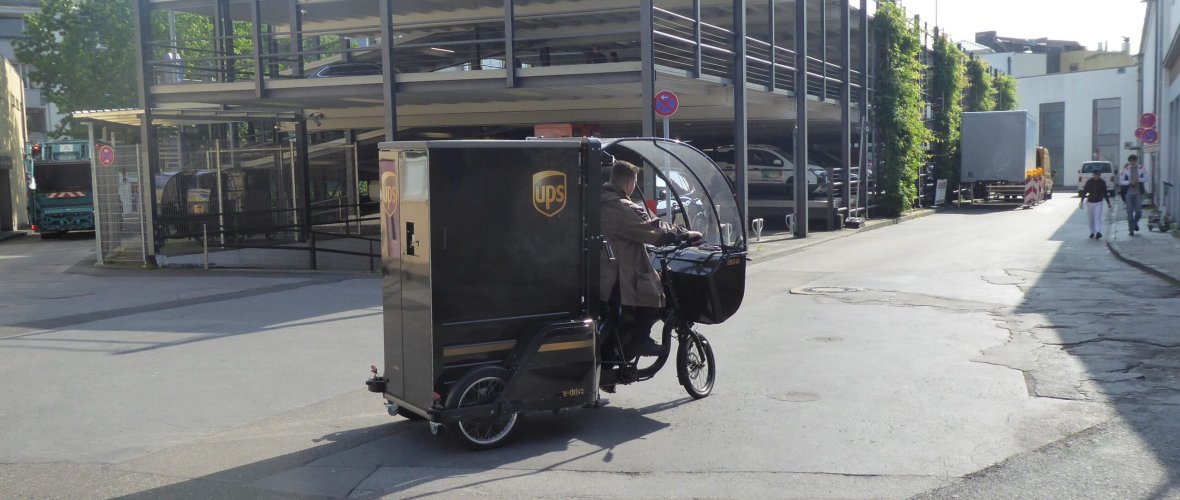Commercial transport & logistics
Commercial traffic in a city is an indispensable prerequisite for the supply of goods and products to citizens and for production and service companies to live and do business.

Urban commercial traffic includes freight and passenger traffic. The commercial goods traffic and works traffic considered here includes freight forwarders, the trades, (urban) service vehicles and courier, parcel and express services (CEP) as well as other traffic such as that of the catering trade. If urban delivery traffic is considered in more detail, the following subdivisions can be made:
- Container transport (20/40-foot containers and swap bodies),
- Bulk transportation (mostly construction site traffic),
- General cargo transportation (containers often on Euro pallets),
- Courier, express and parcel services (CEP shipments up to approx. 40 kg)
Commercial transports can occur as source transports (e.g. dispatch of manufactured products), destination transports (e.g. supply of CEP depots with swap bodies in the nightly main run) and internal transports (e.g. plant transports and CEP delivery tours from the depot to the customers) of a city.
Against the backdrop of steadily rising traffic figures, urban-compatible commercial transport and functioning city logistics can only be reconciled if the municipalities actively plan and coordinate the design and management of delivery traffic in cooperation with stakeholders and implement appropriate measures, also taking into account other traffic development measures and other planning principles.
City-friendly parcel delivery
The gradual conversion of parcel deliveries from combustion vehicles to electric vans and cargo bikes will improve the flow of traffic in Aachen's city center.
Since March 2021, the express and parcel service provider UPS has been operating a mobile micro-depot at the Adalbertstraße parking garage in cooperation with APAG Parkhaus GmbH and the city of Aachen. From here, parcels can be delivered efficiently and in a more climate-friendly way in the city center.
Every morning, several hundred parcels are delivered in the light blue container, which are delivered throughout the day using five electric cargo bikes in the city center. At night, the cargo bikes are safely parked in the multi-storey parking lot and can be recharged there. In the evening, the container is then brought back to the distribution center in Eschweiler with returned parcels for reloading.
Expansion after successful test phase
Following a successful test phase, the micro-depot will now be permanently anchored at the Adalbertstraße parking garage. Switching to cargo bikes as delivery vehicles will not only make the city air cleaner, but will also eliminate the need for large delivery vehicles to park in the second row. The parcel carriers can reach many destinations in the city center more easily by cargo bike and take up less space. This not only makes traffic flow more smoothly, but also safer for all road users.
Fields of action
The city of Aachen's Integrated Climate Protection Concept (IKSK) incorporates numerous measures from the "mobility turnaround" scenario in the three areas of urban transport, regional transport and reduction of vehicle emissions. The aforementioned measures in the five fields of action of commercial transport contribute to the climate protection and transport targets in urban and regional transport and have a direct impact on the reduction of vehicle emissions.
The measures in the five fields of action listed below can make a significant contribution to achieving urban and environmentally friendly commercial transportation by 2030.
Field of action 1 - Urban-friendly logistics concepts
(Digitally monitored) loading zones and loading areas, multi-user/micro-depots/city terminals/regional distribution centers, bundling deliveries, parcel stations, securing areas and infrastructure for commercial transport
Field of action 2 - Regulatory framework
Monitoring of specially designated loading zones for delivery traffic with appropriate signage and ground markings, enforcement of the StVO, enforcement of severe fines
Field of action 3 - Emission-free commercial transport and deliveries
Use of electric and hydrogen delivery and waste management vehicles in municipal departments, businesses and external companies, including infrastructure, use of (e-)cargo bikes and types of transport such as sack trucks, further expansion of the existing extensive e-charging infrastructure, in particular with fast charging stations, in future also for heavy goods traffic above 12 t gross vehicle weight and, depending on the development of the H2 drive market, gradual development of a hydrogen filling station network
Field of action 4 - Communication and cooperation
Continuation and creation of new suitable collaborations, "Aachen Commercial Transport" round table, national and international communication and information platforms, internal administrative, interdepartmental cooperative collaboration in terms of commercial transport
Field of action 5 - Digitalization and data collection Commercial transport
Data collection through surveys, monitoring and tracking, data collection via logistical processes, GDPR-compliant data provision (e.g. OpenData)
Further measures
Loading zones
Delivery vehicles have long been part of the urban landscape of every city. At the same time, the vehicles require a lot of space and often block parts of the road when loading and unloading. The city of Aachen has set up special loading zones to provide space for delivery vehicles.
Parcel boxes
Aachen is testing a new type of logistics service. Online customers can collect their ordered parcels from a single parcel station, even if they are sent by different service providers.
"Mobility Strategy 2030" / commercial transport
How do we organize the mobility of the future? How could a sensible combination of cars, bicycles, local public transport and walking work in Aachen? This was the topic of a citizens' workshop on transport development planning on Saturday, June 13, 2015, at the Elisenbrunnen.